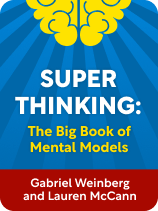

This article is an excerpt from the Shortform book guide to "Super Thinking: The Big Book of Mental Models" by Gabriel Weinberg and Lauren McCann. Shortform has the world's best summaries and analyses of books you should be reading.
Like this article? Sign up for a free trial here.
What is Weinberg and McCann’s Super Thinking about? What is the key message to take away from the book?
In their book Super Thinking, Gabriel Weinberg and Lauren McCann argue that mental models–concepts and patterns used to analyze various situations–provide the framework to optimize decisions amidst uncertainty. More generally, they argue that using these models can lead to super thinking, the ability to accurately understand the world.
Below is a brief overview of the book.
Super Thinking: The Big Book of Mental Models
In their book Super Thinking: The Big Book of Mental Models, Gabriel Weinberg and Lauren McCann provide an array of mental models to improve our decision-making, in life and in business.
In this guide, we’ll proceed from general to specific uses of mental models. While Weinberg and McCann discuss more than 300 mental models, we’ve focused on a limited selection of some of the most useful models. First, we’ll discuss mental models more broadly in Part 1. Next, we’ll discuss mental models designed to avoid pitfalls in reasoning in Part 2, and mental models to use instead in Part 3. Finally, in Part 4 we’ll discuss mental models geared toward creating successful businesses. We’ll provide additional perspectives that expand on–and occasionally push back against–the mental models that Weinberg and McCann recommend.
Part 1 | Mental Models: What They Are and What They’re Good For
We’ll begin by explaining what mental models are, where they come from, and why they’re valuable in decision-making.
In short, mental models are concepts and patterns that help us understand various situations across distinct topics. For instance, the mental model of supply and demand dictates that the relation between supply and demand determines prices: If supply exceeds demand, the price decreases, and if demand exceeds supply, the price increases.
Super Models and Super Thinking
Although mental models arise from a particular context, some mental models are useful outside of their original contexts. Weinberg and McCann call these super models, which are the focus of Super Thinking. By recognizing recurring patterns across disparate fields, super models provide a shortcut to superior reasoning.
For example, consider the concept of critical mass. In physics, critical mass refers to the mass of an atom at which a nuclear chain reaction becomes possible. Once an atom’s critical mass is reached, a chain reaction can occur, causing an explosion. Similarly, businesses reach critical mass when their customer base reaches a certain size, leading to explosive growth of the customer base. Dating apps, for instance, reach critical mass once they have enough members to establish a viable dating pool, because many new members join only after a sufficiently large dating pool exists.
Such models are useful, Weinberg and McCann argue, because they help you achieve super thinking—they provide you the means to more accurately understand the world and its underlying mechanisms. Super models eliminate misconceptions and inefficiencies in our reasoning, instead offering reliable patterns and heuristics to analyze various situations.
By improving our ability to evaluate information, super models improve our decision-making. When used in concert, disparate super models form a set of tools to inform our decisions in virtually any situation.
Part 2 | What to Avoid: Shoddy Reasoning and Unforeseen Consequences
To understand the general advantages of mental models, we’ll discuss mental models that help us avoid common pitfalls in decision-making. This discussion is two-fold: First, we’ll examine models that help us avoid shoddy reasoning, and second, we’ll examine models that help us avoid unintended consequences. By applying these models, we’ll make better-informed decisions whose consequences we understand.
Pitfall 1: Shoddy Reasoning
Weinberg and McCann assert that, when reasoning, we naturally defer to conventional thinking and our intuition, which is our ability to reason subconsciously. However, conventional thinking and intuition are shaped by inflexible assumptions, which means they can be rigid. For example, the practice of bloodletting–withdrawing someone’s blood for medicinal purposes–was part of conventional medical practice because it fit neatly with Humorism, the theory that we’re composed of four humors (blood, phlegm, black bile, and yellow bile). Since Humorism was an entrenched assumption, it led to a rigid belief in the efficacy of bloodletting for roughly 3,000 years until the practice was largely discredited in the late 1800s.
In light of this rigidity, conventional thinking and intuition can mislead us in situations where they’re inappropriate. For instance, in the case of bloodletting, the conventional assumptions of Humorism misled physicians into harming their patients. In this section, we’ll examine such situations so we know when to avoid this type of reasoning.
Inappropriate Intuition
To determine whether intuition is inappropriate, Weinberg and McCann use Daniel Kahneman’s model of fast and slow thinking, outlined in Thinking, Fast and Slow. Kahneman distinguishes between fast thinking, where our mind operates quickly and involuntarily (as in doing basic math), and slow thinking, where we reason carefully and deliberately (as in doing calculus).
They argue that we should avoid leaning on intuition in situations suited for slow thinking. For instance, imagine that you’re an American visiting a less-talkative culture, and none of the locals are willing to talk with you. If you rely on intuition, you might incorrectly conclude they’re impolite or rude, when there are simply different norms at play. In this case, use slow thinking to consider these unfamiliar norms instead of making a snap judgment.
Reason From First Principles
In situations that call for slow thinking, a more helpful mental model is reasoning from first principles. McCann and Weinberg explain that first principles are self-evident assumptions that ground your reasoning. For example, in deciding which career path to pursue, you might follow the first principle that upward mobility is valuable.
First principles provide a sturdy foundation for our beliefs, helping us avoid the shortcomings of conventional thinking. Because the assumptions underlying conventional thinking are often misguided, using first principles can help us avoid them. For example, conventional astronomy once placed the Earth at the center of the solar system. However, Copernicus rejected this conventional view because he accepted the first principle that the most logical mathematical model of stars’ movements was correct. Since the heliocentric model was the best mathematical model of the stars, Copernicus accepted it instead.
De-Risk Assumptions
Still, even seemingly self-evident assumptions can be mistaken. To avoid false assumptions infiltrating your reasoning, Weinberg and McCann recommend another mental model: De-risk your assumptions by testing their validity with objective measures.
This de-risking process can look different depending on the assumption. For instance, a conservative political candidate might assume they’ll comfortably win historically Republican districts. In this case, de-risking might involve conducting a poll to test this assumption.
Account for Your Frame of Reference
False assumptions aren’t only a risk when reasoning from first principles—we’re also susceptible to false assumptions rooted in our own perspective.
For example, consider a model from Einstein’s theory of relativity, the frame of reference. In physics, an object’s frame of reference is roughly its location relative to which its speed and direction can be measured. To oversimplify, we could say that relative to our location inside a moving airplane, we’re currently stationary, though relative to the location of the airport, we’re currently traveling north at 550 mph.
We all have our own personal frames of reference, our subjective experience through which we perceive the world. To reason objectively, we need to keep in mind our own frame of reference and the biases afflicting it. Weinberg and McCann caution that one factor impacting our frame of reference is availability bias, where we overemphasize recently acquired information. For instance, a news report about recent shark attacks might make us think they’re a major issue, when they actually only cause about one fatality every other year.
Another issue caused by our frame of reference is the fundamental attribution error, where we misattribute the motivations of others to character or personality, rather than external factors. For example, if we thought our server was being cold, we might conclude that they’re rude and impolite, not that they’ve just had a bad day.
To combat this error, Weinberg and McCann encourage seeking out the most respectful interpretation of others’ behaviors. Essentially, this involves viewing others’ actions charitably, rather than cynically. This advice squares well with Hanlon’s Razor, a mental model stating that we shouldn’t attribute someone’s behavior to malice if we can instead attribute it to carelessness.
Pitfall 2: Undesired Consequences
Now that we’ve seen how to avoid shoddy reasoning, we’ll learn how to avoid harmful consequences by improving our predictions about the future. To do so, we’ll learn several mental models that illuminate the inadvertent consequences of our actions.
Inadvertently Harming Your Neighbor
The first unintended outcome Weinberg and McCann discuss results from the tyranny of small decisions, where individually reasonable decisions collectively create a worse outcome for everyone. For instance, you might think your vote doesn’t matter and therefore refrain from voting. While this seems reasonable, democracy would crumble if everyone followed suit.
The tyranny of small decisions is especially prevalent regarding public goods, since it’s tempting to think that it won’t matter if we take more than our rightful share. However, public goods can be jeopardized if everyone follows suit, illustrating another mental model: the tragedy of the commons. For instance, during the onset of the Covid-19 pandemic, people flocked to stores to buy excessive amounts of groceries. This created shortages, leaving many without access to vital items.
Failure to Think Long-Term
In a similar vein, some decisions yield benefits in the short term while leading to long-term disaster. To illustrate, consider the mental model based on the boiling frog, which stays in a pot of water as the temperature gradually increases, eventually finding itself boiled alive. Although the increase in temperature feels nice in the short term, it creates a long-term catastrophe.
Weinberg and McCann argue that we’re susceptible to such decisions because of short-termism. In finance, this refers to emphasizing short-term results to the detriment of long-term results. For instance, a company that only focuses on marketing current products might fail to develop new products necessary for future success. Weinberg and McCann suggest that short-termism afflicts our general decision-making as well.
To combat short-termism, heed the precautionary principle and act with extreme caution when an action’s potentially harmful consequences are unknown. More concretely, this involves analyzing potential risk by considering the harmful consequences that an action could lead to. Ask yourself, “Is there reason to think that this action has dangerous consequences?” If the answer is “yes,” pause before acting. By adhering to this principle, Weinberg and McCann suggest we’re less likely to run into harmful consequences down the road.
Part 3 | What to Do Instead: Make Efficient, Well-Informed Decisions
At this point, we have a good grasp of what to avoid when making decisions. Now, we’ll turn to mental models demonstrating what to do instead.
First, we’ll examine the general fundamentals of decision-making, exploring an array of mental models for increasingly complex situations. Afterward, we’ll explore ways to make decisions efficiently, since making the best decision is pointless if it takes an impractical amount of time.
Fundamentals of Decision-Making
Weinberg and McCann assert that decision-making is difficult because nobody has access to perfectly accurate, comprehensive sources of information. Rather, our information is often messy and flawed, so we can’t always predict how our decisions will pan out. In this section, we’ll explore decision-making models to recommend the best choice based on the complexity of the decision.
Least Complexity: Pro-Con List
First, let’s look at the best-known decision-making tool: the pro-con list, which sorts the pros and cons of a decision in parallel columns, making it easier to see the positive and negative consequences. For instance, imagine you’re a lawyer deciding whether to accept a higher-paying position that would require moving away from your family. In this situation, you could draft the following pro-con list of accepting the position:
Popularity notwithstanding, Weinberg and McCann argue that the pro-con list has several flaws:
1. It creates a false dichotomy, since many consequences don’t fit neatly as pros or cons.
2. It fails to weight different pros and cons, so you focus solely on the quantity of pros and cons.
3. The grass-is-greener mentality leads us to naturally overemphasize pros.
So, while a pro-con list may work well enough for simpler decisions, Weinberg and McCann caution against using it in more complex decisions.
More Complexity: Cost-Benefit Analysis
To improve, Weinberg and McCann recommend creating a cost-benefit analysis of your decision. Unlike pro-con lists, a cost-benefit analysis lists the cumulative costs that a decision will incur alongside its cumulative benefits. It thus quantifies the consequences of your decision.
At a rudimentary level, a cost-benefit analysis might weigh individual pros and cons on a scale of 10 to -10, summing these values to recommend a decision—if the total is positive, the decision is worthwhile, and if it’s negative, the cost is too high. Returning to our pro-con list above, you might retool it into the following cost-benefit analysis:
Unlike the pro-con list, the cost-benefit analysis yields a more conclusive verdict: You shouldn’t take the new position, since the cons outweigh the pros.
To further improve your analysis, Weinberg and McCann recommend assigning each cost and benefit an explicit monetary value. For instance, relocating to a new city might cost $10,000, whereas an extra week of paid leave might be worth $3,000.
Most Complexity: Decision Trees
Both the pro-con list and the cost-benefit analysis assume that you’ll know what will result from your decision. But Weinberg and McCann recognize that sometimes, there are many possible outcomes, and you have only a rough idea how likely any given outcome is. For instance, when governments institute new policies, they rarely know the exact consequences beforehand.
In such cases, use a decision tree to handle this uncertainty. In addition to assigning monetary values, decision trees also assign probabilities to each outcome, representing the likelihood that it will occur.
To see this in action, let’s continue the lawyer example with a few caveats: First, if you accept the new position, there’s an 80% chance that you’ll thrive and eventually become a partner. Second, the increased pressure might make you crack, so there’s a 20% chance that you’ll end up getting fired at the new job. Finally, you’re 100% certain that staying at your current job will lock you into your current position—an associate—for the foreseeable future.
Here, there are three possibilities: You accept the new job and become a partner, you accept the new job and crack under pressure, or you stay at your current job and remain an associate. Assuming you’ve assigned these three outcomes values of $100,000, -$50,000, and $75,000, respectively, you can create the following decision tree:
This decision tree lists possible decisions in the first node (rectangles), the likelihood of a given outcome in the second node (ovals), and the monetary value of that outcome in the third node (diamonds).
Crucially, decision trees allow us to calculate each decision’s expected value, the average monetary value resulting from a decision. To do so, multiply the likelihood of each outcome by its respective monetary value, and then sum them up for each decision. If your decision has two possible outcomes, your calculation would look like this:
(Outcome 1 likelihood)x(Outcome 1 monetary value) + (Outcome 2 likelihood)x(Outcome 2 monetary value) = (expected value)
For example, you’d calculate the expected value of accepting the new job with this formula:
(0.8)x($100,000) + (0.2)x(-$50,000) = $70,000
By contrast, the expected value of keeping your current job is more straightforward:
(1)x($75,000) = $75,000
Because the expected value of keeping your current job is higher than that of accepting the new job, the decision tree recommends keeping your current job.
Efficient Decision-Making
So far, we’ve learned how to make decisions amid uncertainty. Now, we’ll focus on making decisions efficiently. To do so, Weinberg and McCann discuss mental models designed to maximize our efficiency. We’ll examine three:
1. Before approaching specific decisions, identify your north star, your overarching goal or vision. When you orient decisions toward your north star, your abilities compound and you become more efficient at pursuing your goals.
2. After identifying your north star, perform deep work, a concept from Cal Newport’s book, Deep Work. This involves spending extended periods of time dedicated to one important task, free of distractions and interruptions. In the long run, performing deep work will yield greater returns than juggling various tasks at once.
3. Perform high-leverage activities to get more out of your decisions. In physics, a lever allows you to lift heavier objects than you could on your own. Similarly, high-leverage decisions create oversized results from less effort.
Part 4 | Professional Uses: Decisions for Successful Companies
So far, we’ve focused on general principles of decision-making, with an eye toward pitfalls to avoid and models to apply instead. In Part 4, we’ll explore more specific uses of mental models, focusing on professional uses for business leaders.
First, we’ll examine mental models to understand general strategies for building successful companies and business models. Next, we’ll focus on building successful teams and helping your employees reach their potential. Then, we’ll examine mental models geared toward increasing and retaining your market power. Finally, we’ll conclude by discussing mental models designed to avoid, or minimize, conflict with competitors.
Use Natural Models to Become Adaptable
In evolutionary theory, the process driving evolution is natural selection. Broadly speaking, natural selection dictates that genes which contribute to genetic fitness—the ability to survive and reproduce—are most likely to be passed down. For example, giraffes with longer necks can reach food more easily than those with shorter necks, which improves their odds of surviving and reproducing. In turn, that trait is more likely to be passed down to future generations.
Weinberg and McCann argue that natural selection likewise applies to societal contexts, as ideas that adapt to society’s evolving preferences are more likely to thrive. Businesses that adapt to these shifting preferences are better positioned for success, while those unwilling to adapt are quickly left behind. Weinberg and McCann provide a variety of mental models to help maximize adaptability and put your business on the path to success.
Overcome Inertia
A primary obstacle to adapting is inertia. In physics, inertia refers to an object’s tendency to continue along the same path in the absence of external forces. For example, if you’re playing billiards and shoot the eight ball toward the corner pocket, it will continue in that direction unless an external force acts upon it.
Similarly, Weinberg and McCann argue that personal and professional inertia makes us resistant to changing our current path, which creates harmful rigidity. To avoid this rigidity, we must constantly question our beliefs and assumptions, and be willing to experiment with change. Netflix exemplifies the value of resisting inertia—in 2007, they shifted from physical DVD rentals to online streaming, upending the entertainment industry.
Create Momentum
Closely related to inertia is momentum. To succeed as a business, Weinberg and McCann propose pursuing ideas and products whose momentum is increasing.
To identify ideas and products with increasing momentum, seek out those about to reach a tipping point. In short, a tipping point is the moment when a system begins to rapidly shift. For example, in the 1990s, Baltimore reached a tipping point that sparked a syphilis epidemic, as a large number of those in high-density areas were exposed.
In business, tipping points occur when products are purchased not only by early adopters—those willing to try new ideas without social pressure—but also by the early majority—those willing to try ideas popularized by early adopters. By remaining aware of trends among early adopters, you can anticipate which products are likely to gain momentum in the future.
Harness Your Team’s Potential
Still, Weinberg and McCann recognize that adaptability alone isn’t sufficient for success—you also have to harness your employees’ potential to build thriving teams.
In particular, Weinberg and McCann’s goal is to build 10x teams, those composed of competent employees positioned to thrive in light of their unique skills. To build these teams, they argue that one obvious strategy—recruiting only all-star employees—won’t work, because Joy’s Law states that most of the smartest, highly talented people in the world always work for someone else. Since you can’t bank on everyone being a natural all-star, it’s crucial to instead harness your employees’ potential.
Organizational Culture
The first step toward building 10x teams is creating a strong organizational culture. In short, organizational culture refers to the shared beliefs, practices, and values of a given organization.
Weinberg and McCann clarify that strong organizational culture isn’t one-size-fits-all. Still, certain steps are essential to shaping a positive culture, including:
- Designate a concrete north star.
- Make your core values explicit.
- Reward employees for outstanding performances.
- Embody your desired norms and values.
By taking these steps, leaders can actively shape company culture in the desired direction.
Winning Employees’ Hearts and Minds
Weinberg and McCann further claim that winning hearts and minds is a key mental model for garnering support. In military contexts, this involves directly appealing to citizens’ emotions and reason to gain their support. For instance, Ukraine employed this model in its war against Russia in 2022, with President Volodymyr Zelenskyy framing the war as one against tyranny and evil, while simultaneously combating disinformation by Russian media.
Similarly, winning hearts and minds in a business context ensures that employees are intrinsically motivated. To do so, clearly communicate values and demonstrate the tangible needs your business meets. In turn, you’ll win employees over to your cause, which encourages them to persevere through challenges. By contrast, employees who are only extrinsically motivated will jump at the opportunity to leave when another offer satisfies their extrinsic desires better—for instance, when a higher-paying job comes along.
Manage the Individual
In addition to team-building, maximizing potential requires managing each employee in the manner best suited to them.
One key to managing individual employees is placing them in roles tailored to their skills. For instance, Weinberg and McCann advise that introverts can be better suited to isolated positions, such as strategic roles, whereas extroverts can perform better in communicative environments, like sales roles.
Similarly, recognizing the specific needs of your organization can clarify which employees to recruit. For instance, generalists—those who prefer learning about a broad range of topics—can thrive in start-ups, where employees need to perform a wider array of tasks. By contrast, specialists—those who prefer learning in-depth about individual topics—can thrive in larger organizations, which can afford to invest in experts.
Guidance Within the Role
Once placed in the optimal role, employees need further guidance and nurturing to maximize their potential.
In particular, Weinberg and McCann argue that managers should encourage deliberate practice from their employees. A notion pioneered by Anders Ericsson in Peak, deliberate practice occurs when we’re placed in situations at the brink of our abilities and receive consistent feedback on our performance. For example, a novice chess player might analyze positions on the edge of their understanding, then review this assessment with an expert coach.
Gain Sustainable Competitive Advantage
Once you’ve learned how to fulfill your team’s potential, the final step is to derive a sustainable competitive advantage. In essence, this is a long-term edge over competitors that you can exploit. For example, Tesla has derived a sustainable competitive advantage by producing its own car batteries, which consistently cuts costs while delivering higher-quality batteries than the competition.
Finding Secrets
Weinberg and McCann suggest that one key to deriving a sustainable competitive advantage is finding secrets. Typically, these are little-known pieces of information that can yield high-leverage opportunities. For instance, in the late ’90s and early 2000s, Canadian sports bettor Bob Voulgaris used data analytics to identify edges when betting, as casinos weren’t yet systematically using analytics. From this secret, he netted millions.
However, secrets can also be well-known information deemed too risky to act upon. For example, the possibility of electric cars was well-known before Tesla; in 1900, they were even the most-purchased car type. Yet, because it was widely assumed that they were financially untenable, traditional automakers decided to focus on gas-powered cars. By challenging this assumption, Tesla exploited a widely known “secret” to become a trillion-dollar company.
While there’s no foolproof method to finding secrets, Weinberg and McCann encourage intellectual curiosity and openness to new ideas from unexpected places. More concretely, they recommend surrounding yourself with people from other fields, since secrets in one field are often well-known in another.
Reaching Product/Market Fit
Despite their importance, Weinberg and McCann argue that secrets alone can’t guarantee success. Rather, they help us design a product that fills a gap in the market and consequently becomes in demand. In other words, secrets help us develop product/market fit.
Product/market fit is pivotal in determining which of various similar products will thrive. After all, although over 170 companies currently produce smartphones, only one of them is Apple. More generally, the first product that reaches perfect product/market fit is likely to succeed.
Customer Development
To achieve product/market fit, Weinberg and McCann advocate engaging in customer development. Simply put, this involves experimenting with your customer base so that you best understand their perspective. By keeping this perspective in mind when creating your product, it’s more likely that your product will be attuned to customers’ wants and needs.
For example, customer development might occur via focus groups, where random samples of customers discuss your product before its launch and share impressions. Harkening back to Part 2, this process lets you de-risk assumptions about your product’s viability and potential. By incorporating the feedback gleaned from customers into further iterations of your product, Weinberg and McCann claim that you’ll be able to quickly reach product/market fit.
Minimize Damage from Conflict
Even with sustainable competitive advantages, successful companies must be wary of conflict with competitors. To that end, Weinberg and McCann offer mental models designed to either avoid conflict altogether or minimize fallout once it begins.
Deterrence
To avoid conflict in the first place, deterrence is a useful strategy. This involves employing a threat to deter the opposition from engaging in conflict. Parents of rebellious children, for example, might deter them from sneaking out by threatening to ground them if caught.
As one particularly useful form of deterrence, Weinberg and McCann recommend the carrot and stick model. This model consists of some form of negative punishment (the stick), alongside some form of positive reinforcement (the carrot). For example, a professor might deter students from skipping class by threatening to reduce their grades while also promising a grade boost for those with perfect attendance. By using this model, you reap the benefits of both punishment and positive reinforcement, which increases the likelihood that conflict will be avoided.
Containment
When deterrence fails, the next step is containment. In short, containment involves taking steps to prevent further escalation and minimizing the damage. For example, if you’re a food distributor who’s realized that customers purchasing a particular food product are falling ill, you might recall that product to stop further damage.
Weinberg and McCann argue that, in the long term, containment can prevent further harm, because conflict left unchecked can start a domino effect of further damage. For example, Blockbuster failed to contain initial conflict with Netflix, with Blockbuster CEO John Antioco spurning a $50 million offer to purchase Netflix. This failure to contain the budding problem created a domino effect, ultimately leading Blockbuster to declare bankruptcy in 2010.
Appeasement
If all else fails, Weinberg and McCann recommend appeasement, even if you have to make significant concessions to your opposition. For example, imagine you’re locked in a legal battle with competitors that threatens to harm your company’s reputation. In this case, it might be worthwhile to make a settlement offer to appease them. By doing so, you make a short-term concession, but prevent possible long-term catastrophe.

———End of Preview———
Like what you just read? Read the rest of the world's best book summary and analysis of Gabriel Weinberg and Lauren McCann's "Super Thinking: The Big Book of Mental Models" at Shortform.
Here's what you'll find in our full Super Thinking: The Big Book of Mental Models summary:
- How to elevate your everyday reasoning and decision-making skills
- Why you shouldn't rely on intuition when making decisions
- How to deter you opposition from engaging in conflict






